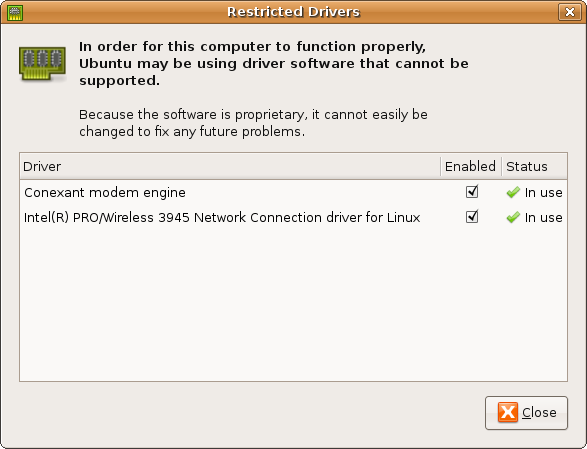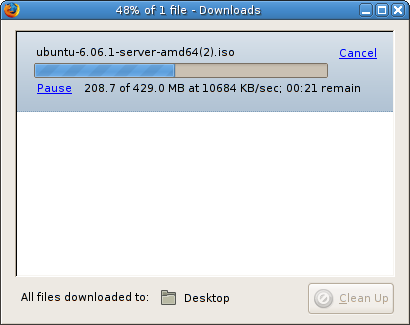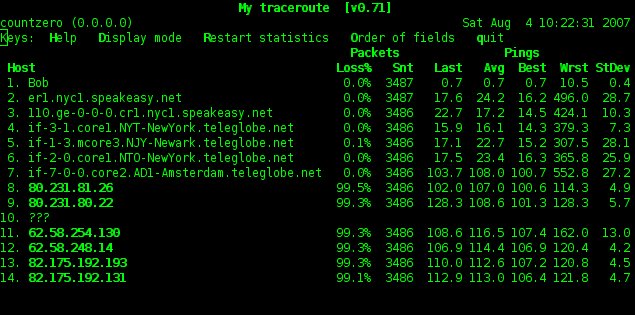My laptop died a couple weeks ago – an almost 4 years old Inspiron 5150 which despite all its overheating problems was quite reliable. Of course it came with Windows XP, but I only ever ran Debian and Ubuntu on it,
Fast-forward to 2007, and now laptops with GNU/Linux preloaded are available.
Of course the perfect laptop would be AMD based with Intel graphics and Ralink wifi. That would have allowed a chance of LinuxBIOS support, free software 3D accelerated graphics, and free software wifi without binary blobs. But this machine does not currently exist, so I ordered a ruby-red Dell Inspiron 1420N with Ubuntu Feisty Fawn preloaded. It arrived today, and here are some first impressions.
First of all, here’s an lspci:
00:00.0 Host bridge: Intel Corporation Mobile Memory Controller Hub (rev 0c)
00:02.0 VGA compatible controller: Intel Corporation Mobile Integrated Graphics Controller (rev 0c)
00:02.1 Display controller: Intel Corporation Mobile Integrated Graphics Controller (rev 0c)
00:1a.0 USB Controller: Intel Corporation 82801H (ICH8 Family) USB UHCI #4 (rev 02)
00:1a.1 USB Controller: Intel Corporation 82801H (ICH8 Family) USB UHCI #5 (rev 02)
00:1a.7 USB Controller: Intel Corporation 82801H (ICH8 Family) USB2 EHCI #2 (rev 02)
00:1b.0 Audio device: Intel Corporation 82801H (ICH8 Family) HD Audio Controller (rev 02)
00:1c.0 PCI bridge: Intel Corporation 82801H (ICH8 Family) PCI Express Port 1 (rev 02)
00:1c.1 PCI bridge: Intel Corporation 82801H (ICH8 Family) PCI Express Port 2 (rev 02)
00:1c.3 PCI bridge: Intel Corporation 82801H (ICH8 Family) PCI Express Port 4 (rev 02)
00:1c.5 PCI bridge: Intel Corporation 82801H (ICH8 Family) PCI Express Port 6 (rev 02)
00:1d.0 USB Controller: Intel Corporation 82801H (ICH8 Family) USB UHCI #1 (rev 02)
00:1d.1 USB Controller: Intel Corporation 82801H (ICH8 Family) USB UHCI #2 (rev 02)
00:1d.2 USB Controller: Intel Corporation 82801H (ICH8 Family) USB UHCI #3 (rev 02)
00:1d.7 USB Controller: Intel Corporation 82801H (ICH8 Family) USB2 EHCI #1 (rev 02)
00:1e.0 PCI bridge: Intel Corporation 82801 Mobile PCI Bridge (rev f2)
00:1f.0 ISA bridge: Intel Corporation Mobile LPC Interface Controller (rev 02)
00:1f.1 IDE interface: Intel Corporation Mobile IDE Controller (rev 02)
00:1f.2 SATA controller: Intel Corporation Mobile SATA AHCI Controller (rev 02)
00:1f.3 SMBus: Intel Corporation 82801H (ICH8 Family) SMBus Controller (rev 02)
03:01.0 FireWire (IEEE 1394): Ricoh Co Ltd Unknown device 0832 (rev 05)
03:01.1 Generic system peripheral [0805]: Ricoh Co Ltd R5C822 SD/SDIO/MMC/MS/MSPro Host Adapter (rev 22)
03:01.2 System peripheral: Ricoh Co Ltd Unknown device 0843 (rev 12)
03:01.3 System peripheral: Ricoh Co Ltd R5C592 Memory Stick Bus Host Adapter (rev 12)
03:01.4 System peripheral: Ricoh Co Ltd xD-Picture Card Controller (rev 12)
09:00.0 Ethernet controller: Broadcom Corporation Unknown device 1713 (rev 02)
0c:00.0 Network controller: Intel Corporation PRO/Wireless 3945ABG Network Connection (rev 02)
The laptop has a built-in SD/MMC slot which is great – it does not have bluetooth though… I’ll have to buy a usb dongle. I like that the machine has 4 usb ports, 2 on each side. There are a series of buttons for sound, and they actually work out of the box. Very nice.
The highest screen resolution available is 1440×900, but only in glossy. I was worried about reflections, but if you turn up the brightness all the way it’s not too bad. This is brightness at less than full strength, which demonstrates the problem with glossy screens:

Free software support for modern hardware is largely problematic in 2 areas: wireless and (3D) graphics. This machine has Intel graphics and wireless; for the former 100% free software drivers are available, but the wireless is still a bit of an issue:

Unfortunately having Intel wireless apparently means having to run a closed-source binary as root (!):
root 3811 0.1 0.0 1704 380 ? S< 15:37 0:02 /sbin/ipw3945d-2.6.20-16-generic --quiet
I really, really don't like that. However, it looks like there is hope - though even a driver without regulatory daemon running as roomt will not be 100% free software because of its dependency on a binary blob (the 'microcode'). I'll have to give the iwlwifi driver a go with the 2.6.22 kernel.
Unfortunately this machine still has a 'windows' key:

But it's really refreshing not to have that Microsoft sticker:

No Microsoft tax was paid on this laptop 
More later, no doubt...







![[Play OGG]](/blog/wp-content/photos/play_ogg_small.png)